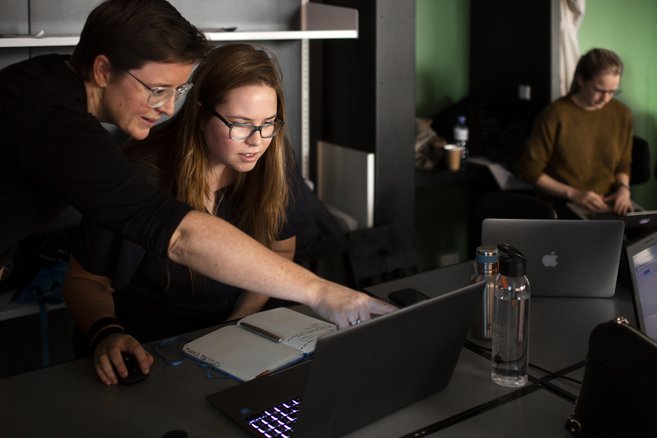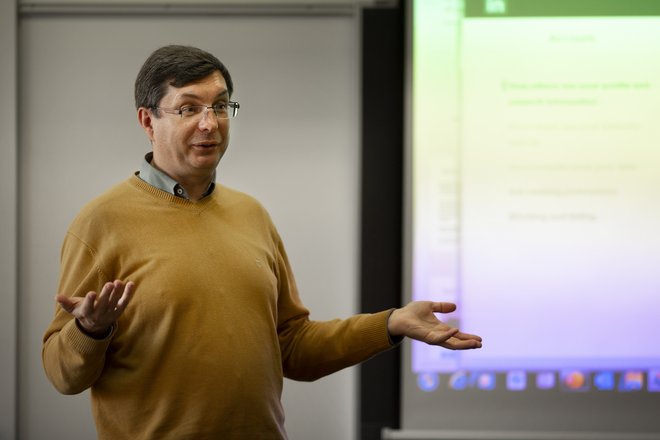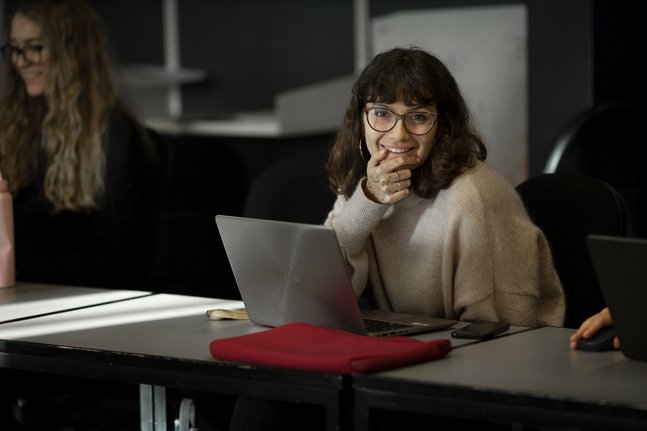Mundus Students Participate in Investigative Journalism Workshop
On an overcast Thursday morning, nearly fifty students of the Erasmus Mundus Master “Journalism, Media and Globalisation” flocked to the Danish School of Media and Journalism in eager anticipation, ready to start the Bellingcat-inspired workshop. Lisa Ossenbrink reports.

The TV auditorium filled with an atmosphere of nervous excitement. This was their first journalistic workshop this semester, and they were looking forward to it. Investigative and data journalism? With these areas at the forefront of innovation, there was a lot to be learnt.
The purpose of the workshop was to equip students with fact-checking and data journalism tools that could be used for investigative research. It was organised by the investigative journalism blog Bellingcat, which publishes findings on human rights abuses and reporting from war zones.
Students were divided into three groups and ventured off to their prospective first workshops.
Inspired by Bellingcat
Founded by the British journalist and former blogger Eliot Higgings in July 2014, Belling became renowned for its innovative methods and investigation into the shooting down of Malaysian Airlines Flight MH17 in Ukraine. Its unique approach lies in the way that satellite images and other publicly available information are used to fact-check if official recollections of the event were true.
With the use of the satellite images, researchers found out from where the shooting most likely occurred. They were also able to conduct that Russian missiles had been used. To dig further into this, Belling looked into the Russian equivalent of Facebook. Here, soldiers or their mothers were sharing information themselves.
Until then, mainstream media hadn’t really picked up on the Ukrainian conflict. Bellingcat helped in creating a counter-narrative. Their investigation ultimately assisted Ukrainians in their struggle as it made the global public aware that this wasn’t a domestic problem. This is just one example of how Bellingcat operates. It demonstrates that doing investigative research is possible even if journalists aren’t on the scene.
Geo-based searching and verification by Penny Sheets Thibaut
Our first workshop was held by the student coordinator at the University of Amsterdam Penny Sheets Thibaut. She showed us how to use maps and locations to find sources and images. By finding locations of photographs or other sources and verifying their authenticity, certain claims could be fact-checked very easily.
When working on an open-source investigation, identifying, verifying and amplying were the three most important steps.
Penny explained how major developments could be monitored by using satellite images and archives with the example of Amsterdam. There, a whole new mini-island was being constructed out of nowhere. Satellite images made it possible to see how the development was growing, slowly but steadily, throughout the years.
Satellite images weren’t the only way to identify or verify locations. Geo-based searching using Google Maps or Streetview were other options.
Another important aspect was image verification. By testing whether a photograph actually entailed all the details of a specific location, it could be verified.

Open data in journalism and in our life by Alex Belyakov
The second workshop was held by a former Mundusian. Alex Belyakov showed us how easy it is to gain information that is supposed to be private from public websites such as LinkedIn. Suddenly, we could access his email address and even private phone number. The ways in which data is accessible with the snap of one’s fingers left a lot of us feeling surprised and even uncomfortable.
He also emphasized how important it was to understand data. The ways in which scientists communicate numerical risks and how journalists cite them are one of the most crucial examples of this. Disinformation can be spread by intent and without looking like it far more easily than presumed.
We were introduced to the fake news debunker inVid which can give external data on youtube links. If someone claims a picture or video was from an event in 2019, but it has been posted before in 2017, it is easily debunked. 
Social Media Investigation Resources by Giovana Fleck
Our fellow Master student Giovana Fleck began talking of the “data frame of mind” that journalists should start adopting to approach their work. She then continued to walk us through over sixteen open-source tools that can be used for social media investigations. Some of these were to see who posted what on Facebook or Instagram. Others included video, photo and website analysis. With one tool, you could access earlier versions of websites. This can give a lot of insight on how changes might have occurred. Social media account analysis could help analysing specific accounts or hashtags.
Giovana later on explained why fact-checking was so important in today’s world: “There’s too much information out there, so we can’t always attest that it’s true. That’s why we need a set of tools and a framework, an ethical one, to actually say that something is more inclined to have happened than other things. The most important thing about fact-checking is to be transparent and say something has been fact-checked so that we can know where data comes from and how to interpret data. It’s not always clear what you can affirm from that data.”
Fact-Checking and Data Journalism More Crucial Today than Ever
Overall, students felt inspired by the learning of the day. When asked why learning about fact-checking was important for journalists today, Canadian scholar Urooba Jamal stated: “For the first time ever, the world has such an unprecedented amount of access to information. This means we need some sort of mechanism to cut through what is and isn’t the truth. Fact-checking more than ever remains an important tool for journalists essentially as arsenal in their work. And it’s going to continue to be a very important part of the journalistic practice.”

In a concluding discussion of the film, students were quick to criticise that Bellingcat itself isn’t transparent about funding or potential biases. Penny Sheets Thibaut countered that every step of the investigation is accounted for by them. If there’s transparency in the process, bias is hard to uphold as evidence found will simply confirm or reject assumptions.
Deepfakes were identified as next big challenge to data journalism as none of the tools introduced would be able to identify them. The trainers smirked, and answered laughingly: “Maybe it’s your job to create one.”
Alex Belyakov emphasized how important it was to have a flexible mind. Problems in the workforce and the digital sphere were ever-evolving, deeming candidates to be creative and innovative in finding solutions. The trainer felt ambivalent about the future of journalism and the changes it might undergo.
Penny Sheets Thibaut ended the workshop with this thought: While journalists might not be privileged sources of information any longer, now they have become a filter and interpreter of information. Assessing what is real and what isn’t has become a crucial part of the job.
If you'd like to apply to join the next cohort of Mundusians who will statr in Aarhus next September, you have until the 10th January 2020 12:00 CET to get your application in.